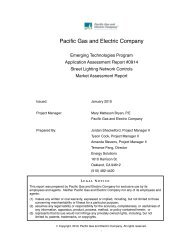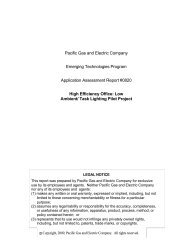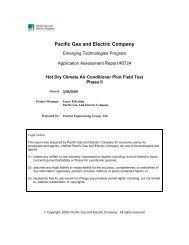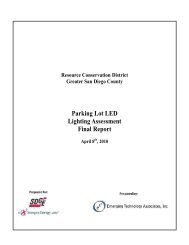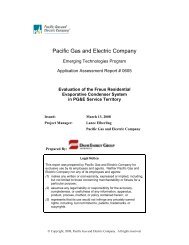Laboratory Evaluation of the OASys Indirect/Direct Evaporative
Laboratory Evaluation of the OASys Indirect/Direct Evaporative
Laboratory Evaluation of the OASys Indirect/Direct Evaporative
You also want an ePaper? Increase the reach of your titles
YUMPU automatically turns print PDFs into web optimized ePapers that Google loves.
Table 4 contains three different measures from <strong>the</strong>se tests as a function <strong>of</strong> <strong>the</strong> inlet dry and wet-bulb<br />
temperatures: <strong>the</strong> resulting supply and exhaust temperatures, and wet-bulb effectiveness. The data shown<br />
are for <strong>the</strong> medium fan speed, representing <strong>the</strong> middle <strong>of</strong> <strong>the</strong> three points shown for <strong>the</strong> supply conditions<br />
in Figure 11. The points that do not have <strong>the</strong> 25°F wet-bulb depression required by ASHRAE are shaded.<br />
The results indicate that <strong>the</strong> unit shows an improvement in effectiveness at higher ambient temperatures.<br />
The key point being that its performance improves as temperatures get higher, as opposed to <strong>the</strong><br />
performance <strong>of</strong> a conventional air conditioner, which gets worse. The effectiveness shows very little<br />
sensitivity to <strong>the</strong> inlet air conditions with a wet-bulb depression above 25°F, but <strong>the</strong> table does show why<br />
a minimum wet-bulb depression is specified in <strong>the</strong> ASHRAE test standards.<br />
Table 4: Performance Measures at Medium Fan Speed and 0.3” <strong>of</strong> Water Supply Pressure<br />
Supply Temperatures (°F)<br />
Intake<br />
Intake<br />
Tdb Wet-bulb Temperature (°F)<br />
(°F) 65 70 75<br />
90 63 68 74<br />
100 61 67 73<br />
110 66 72<br />
Wet-Bulb Effectiveness<br />
Intake<br />
Intake<br />
Tdb Wet-bulb Temperature (°F)<br />
(°F) 65 70 75<br />
90 109% 106% 106%<br />
100 110% 109% 109%<br />
110 110% 109%<br />
491-06.12.doc 18<br />
Exhaust Temperatures (°F)<br />
Intake<br />
Intake<br />
Tdb Wet-bulb Temperature (°F)<br />
(°F) 65 70 75<br />
90 75 78 81<br />
100 80 81 84<br />
110 85 87<br />
Most <strong>of</strong> <strong>the</strong> o<strong>the</strong>r charts from this set <strong>of</strong> <strong>the</strong> data are drawn as a function <strong>of</strong> <strong>the</strong> intake wet-bulb depression<br />
to demonstrate <strong>the</strong> effect <strong>of</strong> <strong>the</strong> changing intake conditions. Figure 20 (in <strong>the</strong> Appendix) is a complement<br />
to Figure 19 in that <strong>the</strong>y both show <strong>the</strong> water consumption <strong>of</strong> this unit, but as a function <strong>of</strong> different<br />
variables. In this chart, <strong>the</strong> water consumption is graphed as a function <strong>of</strong> <strong>the</strong> intake wet-bulb depression<br />
for <strong>the</strong> three fan speeds, and shows a nearly linear increase in water consumption as <strong>the</strong> air becomes<br />
dryer. This chart shows two different measures <strong>of</strong> <strong>the</strong> water consumption. The first is <strong>the</strong> measurement<br />
from <strong>the</strong> flow meter on <strong>the</strong> supply line, and <strong>the</strong> second is <strong>the</strong> calculated water evaporation rate as<br />
determined from <strong>the</strong> measures <strong>of</strong> airflow and humidity. Since <strong>the</strong> system did not have a constant bleed<br />
for maintaining water quality, and <strong>the</strong> flush system was not allowed to operate during a test, <strong>the</strong>se<br />
measures are essentially equivalent. The slopes <strong>of</strong> <strong>the</strong> lines fitted to <strong>the</strong> results are indicated for<br />
comparison with <strong>the</strong> results reported in earlier reports.<br />
Figure 21 shows <strong>the</strong> wet-bulb effectiveness as a function <strong>of</strong> <strong>the</strong> intake wet-bulb depression, grouped by<br />
fan speed and intake dry-bulb temperature. This chart shows that <strong>the</strong>re is an apparent increase in<br />
effectiveness as <strong>the</strong> wet-bulb depression rises, but a small decrease for <strong>the</strong> same depression at a higher<br />
dry-bulb temperature. This may be due to changes in airflow due to its decreased intake density,<br />
increased evaporation rates, or <strong>the</strong>rmal expansion <strong>of</strong> air passages. Of particular concern from this chart is<br />
that <strong>the</strong> ASHRAE test standards only specify a minimum intake wet-bulb depression <strong>of</strong> 25°F, but <strong>the</strong><br />
effectiveness does not remain constant above this level. However, <strong>the</strong>re does appear to be a sharper<br />
downturn in effectiveness below this value. The averages for all <strong>of</strong> <strong>the</strong> effectiveness measures at or above<br />
<strong>the</strong> ASHRAE minimum for each fan speed are also indicated in this chart, and are what may be used to<br />
calculate <strong>the</strong> Title-20 ECER.




